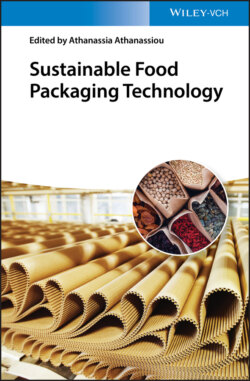Читать книгу Sustainable Food Packaging Technology - Группа авторов - Страница 20
1.3.5 Bio‐based Polyethylene
ОглавлениеBio‐based polyethylene (bio‐PE), also called “microbial” or “green” polyethylene, can be produced by the catalytic dehydration of bioethanol obtained by microbial fermentation, followed by normal polymerization to produce polyethylene (PE) [69, 70]. Bio‐PE is not biodegradable and has the same properties as PE made from natural gas or oil feedstocks [29]. Conventional PE is manufactured by polymerization of ethylene under pressure, temperature, in the presence of a catalyst. Traditionally, ethylene is produced through steam cracking of naphtha or heavy oils or ethanol dehydration. However, the concept of producing PE from bioethanol is not particularly new. In the 1980s, Braskem (São Paulo, Brazil) had already made bio‐PE from bioethanol, however, the limitations of the biotechnology processes made the technology unattractive at that time [71]. Currently, bio‐PE produced on an industrial scale from bioethanol is derived from renewable feedstocks, including sugarcane and beet, starch crops such as maize, wood, wheat, corn, and other plant wastes through microbial strain and biological fermentation process. In a typical process, extracted sugarcane juice with high sucrose content is anaerobically fermented to produce ethanol. At the end of the fermentation process, ethanol is distilled in order to remove water and to yield an azeotropic mixture of hydrous ethanol. Ethanol is then dehydrated at high temperatures over a solid catalyst to produce ethylene and, subsequently, bio‐PE [69, 72]. Figure 1.4 shows a schematic flow diagram of the bio‐PE production.
Figure 1.4 Schematic flow diagram of the production of bio‐based polyethylene (bio-PE) from sugarcane via fermentation into ethanol and subsequent dehydration into ethylene.
Source: From Koopmans [73]. © 2013, John Wiley & Sons.
Braskem is the largest producer of bio‐PE, mainly bio-based high-density polyethylene (bio-HDPE), with 52% market share, with an annual production capacity of 200 000 tons per year made from ethanol obtained from sugarcane [71] and this is the first certified bio‐PE in the world. Similarly, Braskem is developing other bio‐based polymers such as bio‐based polyvinyl chloride (bio‐PVP), bio‐based polypropylene (bio‐PP), and their copolymers with similar industrial technologies. Braskem's current bio‐based PE grades are mainly targeted toward food packaging, cosmetics, personal care, automotive parts, and toys. Dow Chemical (Midland, USA) in cooperation with Crystalsev (São Paulo, Brazil) is the second largest producer of bio‐PE, having 12% market share. Solvay (Brussels, Belgium), another producer of bio‐PE, has 10% share in the current market. However, Solvay is a leader in the production of bio‐PVC with similar industrial technologies. China Petrochemical Corporation (Pekin, China) also plans to set up production facilities in China to produce bio‐PE from bioethanol [74]. LyondellBasell (Rotterdam, The Netherlands) and Neste (Espoo, Finland) have recently announced the first parallel production of bio‐PP and bio‐based low‐density polyethylene (bio‐LDPE) at a commercial scale, being marketed under the trade names Circulen and Circulen Plus [75].
Bio‐PE can replace all the packaging applications of current fossil derived PE because of its low price, good lifetime performance, and especially recyclability [75]. The price of bio‐PE is currently about 50% higher as compared with petrochemical PE, but it will take advantage from the scale‐economy. Current upcoming applications by multinationals include yogurt cups produced by Danone (Paris, France), fruit juice bottles by Odwalla (Atlanta, USA), and plastic caps and closures for aseptic paperboard cartons by Tetra Pak (Lund, Sweden) [76].
